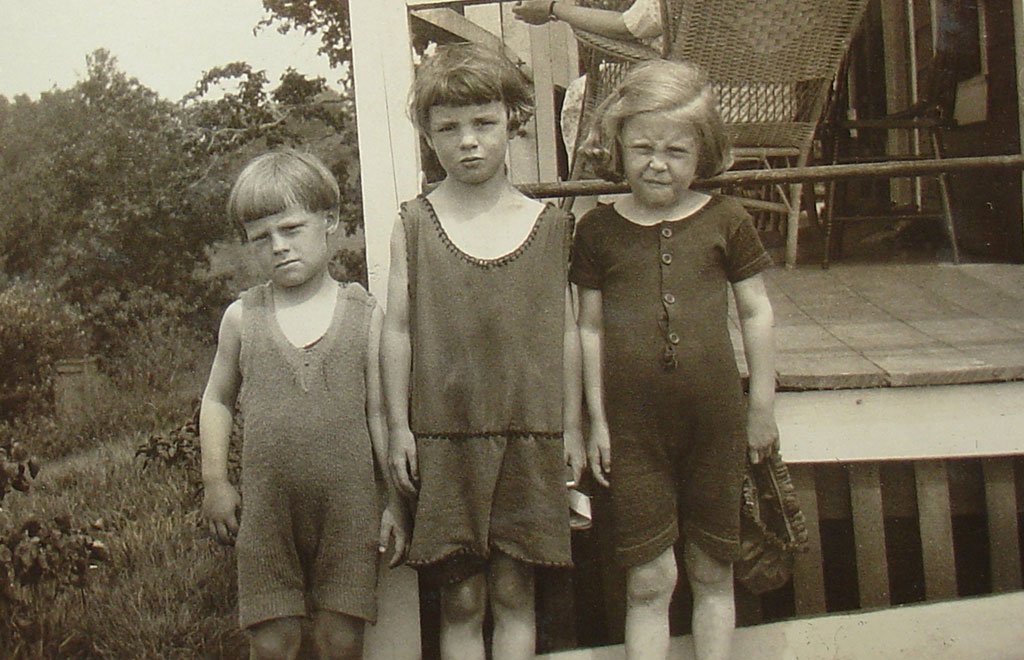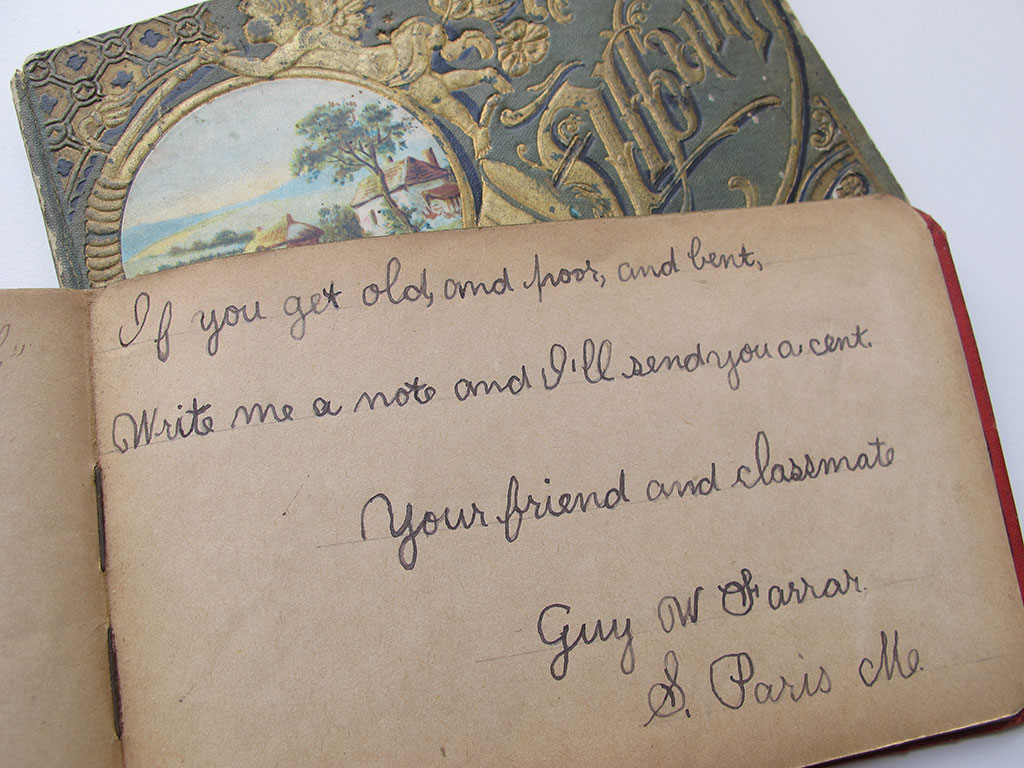Introduction
Many of us have collections of personally significant materials. These may include diaries and letters handed down through generations or photographs of significant life events or even a set of old tickets stubs, but our diverse collections create a record of who we are and where we come from. These paper-based collections deteriorate over time, but making small changes in storage and handling can have a huge impact on the lifespan of the materials.
Controlling the environment
The best protection for your books, papers, photographs, and prints is a cool, dry, stable environment with good air circulation and limited light exposure. A collection’s lifespan can be significantly improved just by keeping temperatures around 70 degrees Fahrenheit and relative humidity (RH) under 55%. In the home, living spaces tend to stay within this range, while attics and basements tend to experience temperature extremes, poor air flow, and moisture problems. Choosing a location with steady temperature and RH will reduce risks from pests, mold, and chemical deterioration.
Once you have chosen a storage location, look around. Is there a water source nearby? Are radiators, heating vents, fireplaces or other heat sources creating localized high temperatures? Is there anything on the floor above that could cause problems? Does sunlight stream into the room? Is the room lit with fluorescent lights? Is there evidence of mice or insects? Knowing the answers to these questions will guide your preservation actions.
Quick Reference: Environmental Control
- Create a stable environment. A good target is 70 degrees Fahrenheit and RH below 55%, but work within your means.
- Avoid storing items in the attic or basement.
- Avoid storing material along outer walls, which tend to experience temperature fluctuations.
- Avoid storing items near heat sources.
- Avoid storing items near or below water sources.
- Store material at least four inches off of the floor to reduce risk of damage from floods and leaks.
- Use blinds and curtains, and keep lights off, to reduce fading and damage from light exposure.
- Dust and vacuum regularly to discourage pests.
It is impossible to avoid all sources of risk, but awareness of possible hazards will allow you to prepare for and respond to any problems that arise.
 Storage Enclosures
Storage Enclosures
While stabilizing the environment will offer the broadest benefit to your collections, housing items in storage enclosures provides another layer of protection. Enclosures provide structural support, protect contents from tears, breaks, slumping, or other distortion, and reduce damage from airborne pollutants. Preservation-quality paper or chemically stable plastic enclosures can be used, and are suitable for a variety of materials.
Paper Enclosures
Look for terms that indicate the stability of the boxes, mats, folders, and other paper enclosures. In general, you will want acid-free,lignin-free, buffered materials. Lignin is a component in paper that leads to the formation of harmful acids that cause brittleness and discoloration. Buffered materials have had a buffering agent (such as calcium carbonate) added during manufacture to neutralize these acids as they form over time. While buffered paper enclosures are generally preferred, blueprints, some inks and paints, and some photographs are sensitive to alkaline buffering. Unbuffered enclosures are difficult to find, but unbuffered tissue paper is readily available. Alkaline sensitive materials can be be protected by placing the unbuffered tissue paper between the item and the buffered folder or box.
Be aware that paper enclosures labeled acid-free with no further qualifiers are only acid-free at the point of manufacture. These enclosures may become acidic relatively quickly, leading to deterioration of the items within.
Plastic Enclosures
Plastics work well in instances where it is important to be able to see an item while avoiding unnecessary handling, but not all plastics are safe for collections. Acetates can change dimension and enclosures made from polyvinyl chloride (PVC) release harmful compounds that may affect the stability and appearance of collection materials. There are safe options, though. Preservation-grade polyester (often sold under the trade name Melinex) is the most stable, but polyethylene or polypropylene can also be used safely if they do not contain plasticizers.
When considering paper or plastic enclosures for photographs, choose materials that pass the Photographic Activity Test (PAT). This guarantees that the enclosure will not react chemically with photographs.
Quick Reference: Choosing Enclosures
- Choose boxes without gaps or handle holes and with snug lids to help exclude dust and pollutants.
- Use acid-free, lignin-free and buffered paper, board and tissue, unless the object is alkaline sensitive.
- Use polyester, polyethylene or polypropylene if plastic enclosures are preferred.
- Paper and plastic enclosures for photographs should pass the PAT.
- The size and shape of envelopes, boxes, and folders should match the objects they hold.
- Purchase or make custom-fitted book boxes to ensure proper support and fit.
 Specific Concerns
Specific Concerns
Envelopes
Store documents in folders rather than envelopes to reduce damage from handling as items are removed and replaced.
Folded or Rolled Materials
Repeated folding and unfolding causes breaks in the paper along the fold lines. Papers should be flattened for storage, if possible. Care should be taken when unfolding or unrolling items and efforts should be discontinued if the paper shows signs of brittleness or breaking.
Resist the urge to counter-fold along creases, as this will further weaken the already fragile paper fibers.
Framed Items
Any valuable photo or artwork on display should be protected by a preservation-quality mat and frame. Glazing protects the item from pollutants and dirt, and choosing UV filtering glass or acrylic reduces light damage. Learn more about proper framing techniques: "What's Behind Your Frame?"
News Clippings
Photocopy brittle or damaged news clippings onto acid-free, lignin-free, buffered paper. Store copies separately from originals, or, if stored together, place a sheet of interleaving paper between the original and the copy to reduce acid migration.
Odors in Books
MicroChamber® products, which contain Zeolite molecular traps, have proven very effective in removing odors. Place a sheet of the paper between the front board and the endpaper, then approximately every 20 pages throughout the volume, and again between the back board and endpaper. Close the book and set it aside for a month. The smell should be reduced, but the process may need to be repeated for complete elimination.
Photographs and Prints
When storing photos in an album, use “photo” or mounting corners. Choose a photo album with buffered or neutral, good-quality paper and/or preservation-quality polyester, polypropylene, or polyethylene pages. Ensure materials have passed the PAT.
Removing Fasteners Safely
Slide a piece of stiff plastic (e.g., polyester, polypropylene) under the paperclip or staple on both sides of the document to help protect the paper from damage as you work. Then slide the paper clip off, or bend the edges of the staple up and pull it out with a pair of tweezers or a thin knife.
Conclusion
Family collections tie us to our past. With a bit of thought and a small amount of effort, these collections can be preserved and protected. By assessing storage options, becoming aware of risks to materials, and making informed decisions, you can drastically improve the lifespan of your materials at little or no cost.
LEARN MORE
Caring for Private and Family Collections
A great resource for families as well as local libraries and historical societies.
READY-TO-USE HANDOUT
Guidelines for Framing
"What's Behind Your Frame?" Know before you frame!


